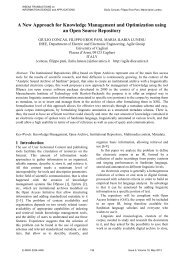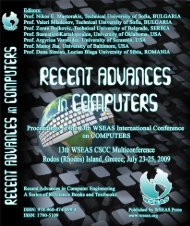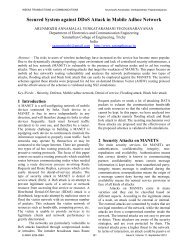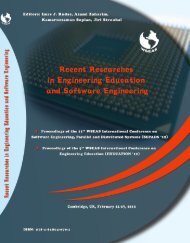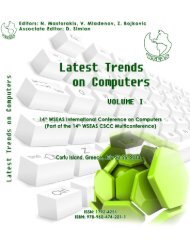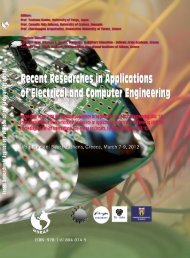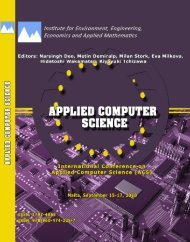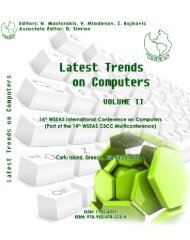Heuristic Search Method for Digital IIR Filter Design - WSEAS
Heuristic Search Method for Digital IIR Filter Design - WSEAS
Heuristic Search Method for Digital IIR Filter Design - WSEAS
You also want an ePaper? Increase the reach of your titles
YUMPU automatically turns print PDFs into web optimized ePapers that Google loves.
<strong>WSEAS</strong> TRANSACTIONS on SIGNAL PROCESSING<br />
Ranjit Kaur, Manjeet Singh Patterh,<br />
J. S. Dhillon, Damanpreet Singh<br />
searching multidimensional and multimodal spaces,<br />
but are also able to optimize complex and<br />
discontinuous functions that are difficult to analyze<br />
mathematically. The use of the genetic algorithm <strong>for</strong><br />
the digital <strong>IIR</strong> filter design is practical and attractive<br />
[10] as the filter can be constructed in any <strong>for</strong>m,<br />
such as cascade, parallel, or lattice and also the lowpass<br />
(LP), high-pass (HP), band-pass (BP), and<br />
band-stop (BS) filters can be independently<br />
designed. Further the classical analog-to-digital<br />
trans<strong>for</strong>mation is avoided. Multiobjective functions<br />
can be simultaneously solved and the obtained<br />
model can be of the lowest order. Un<strong>for</strong>tunately, the<br />
per<strong>for</strong>mance of genetic algorithm based methods is<br />
often compromised by their very slow convergence<br />
and they may be trapped in the local optima of the<br />
multiobjective functions when the number of the<br />
parameters is large and there are numerous local<br />
optima [22]. There<strong>for</strong>e, it is worthy of further<br />
developing an efficient heuristic algorithm to solve<br />
the problem of designing the optimal digital <strong>IIR</strong><br />
filters. A hybrid Taguchi genetic algorithm has been<br />
applied by Tsai et al. [23] to solve the problem of<br />
designing optimal digital <strong>IIR</strong> filters. The hybrid<br />
Taguchi genetic algorithm approach is a method of<br />
combining the traditional genetic algorithms, which<br />
has a powerful global exploration capability, with<br />
the Taguchi method, which can exploit the optimum<br />
offspring. The Taguchi method is inserted between<br />
crossover and mutation operations of traditional<br />
genetic algorithms. While genetic algorithm rapidly<br />
locates good solutions, even <strong>for</strong> difficult search<br />
spaces, it has some disadvantages associated with it:<br />
genetic algorithm may converge towards local<br />
optima rather than global optima if the fitness<br />
function is not defined properly; it is difficult to<br />
operate genetic algorithm on dynamic sets.<br />
Conventional optimization algorithms may find<br />
better solutions than genetic algorithm in same<br />
computation time.<br />
Particle swarm optimization technique attains<br />
high quality solutions within shorter calculation<br />
time and stable convergence characteristics than<br />
other stochastic methods such as genetic algorithm<br />
by virtue of being population based optimization<br />
algorithm. Based on a variation of particle swarm<br />
optimization, namely, quantum-behaved particle<br />
swarm optimization, Sun et al.[24] have proposed<br />
quantum-behaved particle swarm optimization with<br />
diversity-guided mutation <strong>for</strong> the design of 2-D <strong>IIR</strong><br />
digital filters. The per<strong>for</strong>mance of particle swarm<br />
optimization or its variants depends on its<br />
parameters and may be influenced by premature<br />
convergence and stagnation problem [25]. A seekeroptimization-algorithm-based<br />
evolutionary method<br />
has been proposed by Dai et al. [16] <strong>for</strong> digital <strong>IIR</strong><br />
filter design. Seeker optimization algorithm is based<br />
on the concept of simulating the act of human<br />
searching in which the search direction is based on<br />
the empirical gradient by evaluating the response to<br />
the position changes and the step length is based on<br />
uncertainty reasoning by using a simple fuzzy rule.<br />
Although seeker-optimization-algorithm is easy to<br />
be implemented and good at local convergence,<br />
depending upon the initial solution, it might often<br />
require too many cost function evaluations to<br />
converge to the global minima [16].<br />
Recent heuristic method, namely immune<br />
algorithms mimic the antigen-antibody reaction of<br />
the immune system in mammals. The antigen and<br />
the antibody in the immune algorithms are<br />
equivalent to the objective function and the feasible<br />
solution <strong>for</strong> a conventional optimization method.<br />
The clonal selection principle of immune algorithms<br />
facilitates the efficiency of solving the numerical<br />
optimization problems. However, the characteristics<br />
of the immune algorithms are similar to those of the<br />
traditional genetic algorithms, which are largely<br />
based on the stochastic search techniques, have<br />
larger standard deviations. The obtained result is<br />
more robust if the relevant fitness values have a<br />
smaller standard deviation. A robust approach by<br />
integrating the immune algorithm and the Taguchi<br />
method named as Taguchi-immune algorithm has<br />
been purposed by Tsai and Chou [21] . Cooperative<br />
co-evolutionary genetic algorithm <strong>for</strong> digital <strong>IIR</strong><br />
filter design has been proposed by Yu et al. [26].<br />
The magnitude response and the phase response has<br />
been considered simultaneously and also tried to<br />
find the lowest filter order. The structure and the<br />
coefficients of the digital <strong>IIR</strong> filter have been coded<br />
separately, and they evolve coordinately as two<br />
different species, i.e., the control species and the<br />
coefficient species. The non-dominated sorting<br />
genetic algorithm-II has been used <strong>for</strong> the control<br />
species to guide the algorithms toward three<br />
objectives simultaneously. The simulated annealing<br />
has been used <strong>for</strong> the coefficient species to keep the<br />
diversity but it may require too many function<br />
evaluations to arrive at global minima [17]. Various<br />
methods exist in the literature that addresses the<br />
optimization problem under different conditions.<br />
Different optimization methods are classified based<br />
on the type of the search space and the objective<br />
function. In <strong>IIR</strong> filter design problems, the<br />
evaluation of candidate solutions could be<br />
computationally and/or financially expensive since<br />
it requires time-consuming computer simulation or<br />
expensive physical experiments. There<strong>for</strong>e, a<br />
method is of great practical interest if it is able to<br />
E-ISSN: 2224-3488 122 Issue 3, Volume 8, July 2012




